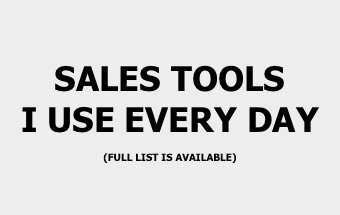You already know it’s important to ask smart sales questions. You read the articles and the books, telling you how important questions are to making the sale.
The problem is learning how to ask smart sales questions.
Which is more than just merely understanding the importance of asking questions.
Most articles, blog posts, and books I read in the past, only talked about “the Why”. But I needed to understand “the How”. I needed a formula to develop the right questions to get customers buying whatever product I was selling.
Today, I’m going to share with you the Gumball Formula that will enable you to actually formulate the right questions to ask your target customers to sell your product.
The Gumball Formula (simple way to ask smart sales questions)
One of the top performing sales guys I used to work with, always told me, “never ask a question you don’t want the answer to.”
What he meant by that was, avoid backing yourself into a corner. Let’s say you were selling Gumballs down at your local downtown street corner.
And let’s say, when a potential customer approached you, you asked, “Hey, do you like gumballs?”
And they responded with an immediate, “No”.
You would find it very difficult to make a sale based on this verbal exchange. They obviously did not like the gumballs they tasted in the past. And since you asked them whether they liked gumballs, you unintentionally associated your gumballs with those they tasted in the past.
At this point, it’s very difficult to change their way of thinking. You have backed yourself into a corner because you asked a question you didn’t necessarily want the answer to. It’s so easy to make this mistake and so hard to grow your sales if you continue to do so.
Let’s go through how we formulate a better sales question to achieve your desired outcome.
Simple step-by-step process for using “the Gumball Formula” to sell your product
There are three simple steps for using “the Gumball Formula“.
Step 1: Define all the benefits of your product
Step 2: Get to know your target customers
Step 3: Ask them questions to confirm what you already know
I’ll go through each step in greater detail to boost your sales results.
Step 1: What are all the benefits of your product?
If you don’t have a destination, you can’t figure out how to get there. In every sale you make, your product benefits are the destination.
Think about it. The progression of any sale you make starts with an introduction to a potential customer (call it whatever you want; prospect, lead, whale), then moves to understanding their specific situation, discovering their needs, and then finally matching your product benefits to their situation and needs.
Your product benefits are the destination. You will ultimately arrive at sharing them with your potential customer, but not until you have gathered enough information about them.
To develop smart sales questions, you have to work backwards from your sales destination.
So first, list out all your product features and their associated benefits.
If you have multiple product lines, write out the features and benefits to each of them individually. Then go back and include any overarching benefits gained from selling your different products together. Like the benefits I list for joining the Senator Club.
When you’re selling Gumballs, it may look something like this:
List of Gumball Features; and Benefits
- bigger; can chew for longer
- sugar free; healthier, doesn’t rot your teeth
- multiple colors; fun for kids
- tropical flavors; delicious tasting
- natural flavoring; keeps flavor for longer
Be thorough in developing your own list. This exercise will take longer than 30 minutes. Set aside 2 hours to thoroughly brainstorm all your product features and benefits.
Sometimes your product provides unintentional benefits that you weren’t initially aware of… slow down. Go through all of them before you move onto the next step.
Step 2: Get to know your target customers
Think about the next step back in the sales process. Before you share your product benefits with the potential customer. What are you doing?
Gathering information. That’s right. Understanding their specific situation and discovering their needs.
Using the Gumball Formula, keep working your way back from your sales destination, your product benefits. After you write out your product features and benefits, write down a detailed profile of your target customer.
This is so important.
Look at your product features and benefits, then describe exactly who benefits most from your product. What is their specific situation? What are their specific needs?
Write down all the different attributes to describe your target customer. Start with the most ideal customer profile, then expand your list with other target customer profiles. For example:
Gumball Target Customer Attributes
- Situation: 35 year-old, Mom, with 2-kids under 12, 40 lbs overweight, wearing a pink, long-sleeve cotton shirt with high waisted jeans
- Needs: to keep kids happy, healthy, and quiet; to eat a delicious snack right now at an attempt to quell an insatiable appetite; to eat a delicious snack later
Once you complete step 2, you then use this information to formulate smart sales questions in step 3. Still moving backwards through the sales process.
Step 3: Ask them questions to confirm what you already know
Now that you know your target customer profile, and you know all your product features with their corresponding benefits, you can better develop the right sales questions.
Think back to your local downtown street corner where you are selling Gumballs.
Of all the people that could possibly walk by your Gumball stand, you want the 35-year old, Mom with 2 kids to walk by. Because her customer profile is most likely to buy your product.
You understand her situation and needs. You understand how your product features and benefits help meet her needs. You know this about your target customer really well.
The problem is that your target customer, isn’t always walking by your Gumball stand.
Same goes for your sales call, meetings or website visitors. You are not always dealing with your target customer. But they may share many similarities.
Your goal is to find out what they are and relate to them.
You have to confirm their actual situation. You have to learn what similar qualities and characteristics they posses of your target customer profile.
And you do that by asking smart questions.
This is the final and most important step to the Gumball Formula, formulating your question. Develop your questions by matching your product features and benefits to asking a question about your customer’s attributes.
Such as the following:
- Example #1: Because my gumballs are sugar free, they are healthier for kids and won’t rot their teeth –> Do your kids love candy, but you want them to stay healthy?
- Example #2: Because my Gumballs have natural flavoring, the delicious taste last longer –> How would you like to try a lite snack, that tastes like candy with longer lasting flavor?
For both examples, I chose a specific feature and corresponding benefit, then asked a question confirming the situation and need it would fulfill.
By doing so, you have now asked a question whose response will lead you to your destination of sharing your benefits. Then you already have a smart response after they answer your question.
Build your sales questions backwards. It gives you the clearest understanding of where to direct the sale because you have already specified the destination. This approach to asking questions will get customers buying faster than questions like, “Do you like gumballs?”
What you should do next
Write out your own examples using this sames method. Spend 2 hours to explore different ways to ask your sales questions. Over time, you will be able to formulate smart questions on the fly. I personally work on this every day when I’m on the phones.
Will the Gumball Formula help you? Write your thoughts in the comments below.





10 Comments How to Ask Smart Sales Questions to Sell Your Product